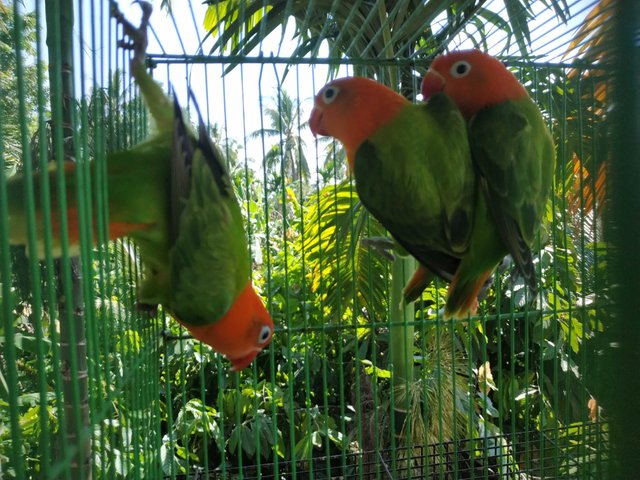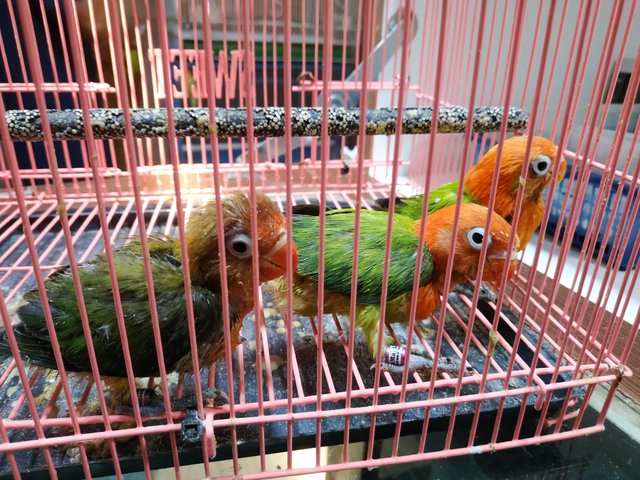Lovebird: Opaline x Opaline {Billangual}
According to the formula, opaline x opaline = 100% opaline. Is there a possibility that opaline x opaline will produce a green color, aka wild color, aka "josan"? Several times we saw a post from a colleague who said that they got an ordinary green (non opaline) bird from the opaline x opaline cross.

Postings like this are usually immediately responded to and there is a prolonged debate and often cynical: "Children who are confused" "Exchanged eggs" "The mother cheats" "Breeders are less picnic" to "You are lieu" ... etc.

Return to the question above. Is it possible for opaline x opaline to produce a green color, aka wild color, aka "josan"? The answer is THERE! Although it is very rare, the possibility does exist. How can this deviation occur? Here's the explanation:
A. A cynical answer that says that the "breeder is cheating" is one of the factors causing the above deviations. According to an article written by Dirk Van den Abeele, female birds have the ability to store male sperm for a certain period of time where the sperm is stored in a small channel located in the cloaca (sperm-storage tubules). The period of storage varies between species and can reach up to 30 days. So it could be that opaline females before being married by opaline males have been "ravished" by males that are not opaline and the sperm is stored by the female until fertilization occurs when mated with opaline males. So it is true that "the mother breed cheats".
B. The second possibility is when reproductive cell formation, there is a part of the Z chromosome containing information that the mutation in question is damaged or lost (males have 2 Z chromosomes while females have 1 Z chromosome and 1 W chromosome). You need to know that when the meiosis process is in progress, there can be several crossing over activities. This crossing over occurs on the male Z chromosome which as a whole has four chromatids and on the female Z chromosome which has two chromatids. The term crossing over is actually more complicated than just the exchange between two chromosomes. If there are parts of the Z chromosome that are problematic (damaged or missing) then there are two possibilities that can occur:
-Embrio does not develop and die in the shell (Dead in Shell).
-Embrio develops and survives but does not inherit the mutation properties of the two sires (in this case opaline) and looks green aka wild color aka "josan" and is believed to be barren.
From the explanation above, although the possibility is very small but indeed it can happen that opaline x opaline = non opaline. In this world, the only constant is change. If there is no deviation, the world of genetics is not the world of genetics.
Menurut rumus, opaline x opaline = 100% opaline. Adakah kemungkinan perkawinan opaline x opaline menghasilkan warna hijau alias wild colour alias “josan”?
Beberapa kali kita melihat postingan dari rekan rekan yang mengatakan bahwa mereka mendapatkan burung berwarna hijau biasa (non opaline) dari hasil silangan opaline x opaline.

Postingan seperti ini biasanya langsung ramai ditanggapi dan terjadi perdebatan berkepanjangan bahkan sering ditanggapi dengan sinis:
“anak yang tertukar”
“telor yang tertukar”
“indukannya selingkuh”
“peternaknya kurang piknik” hingga
“bakul tukang tipu”..dll

Kembali ke pertanyaan diatas. Apakah ada kemungkinan perkawinan opaline x opaline menghasilkan warna hijau alias wild colour alias “josan”? Jawabannya ADA!
Walaupun sangat jarang tapi kemungkinan itu memang ada. Bagaimana penyimpangan ini bisa terjadi?
Berikut penjelasannya:
A. Jawaban sinis yang mengatakan bahwa “indukannya selingkuh” adalah salah satu faktor penyebab terjadinya penyimpangan diatas. Menurut artikel yang ditulis oleh Dirk Van den Abeele, burung betina memiliki kemampuan menyimpan sperma jantan hingga jangka waktu tertentu dimana sperma tersebut disimpan disebuah saluran kecil yang berada diarea kloaka (sperm-storage tubules). Jangka waktu penyimpanan tersebut berbeda antara spesies yang satu dengan lainnya dan bisa mencapai hingga 30 hari. Jadi bisa saja betina opaline sebelum dikawini oleh jantan opaline sudah pernah “ditiduri” oleh jantan yang bukan opaline dan spermanya disimpan oleh sang betina hingga terjadi pembuahan pada saat dikawinkan dengan jantan opaline. Jadi memang benar terjadi “indukannya selingkuh”.
B. Kemungkinan kedua adalah pada saat pembentukan sel reproduksi, ada bagian dari Z kromosom yang mengandung informasi mutasi yang bersangkutan mengalami kerusakan atau hilang (jantan memiliki 2 kromosom Z sedangkan betina memiliki 1 kromosom Z dan 1 kromosom W). Perlu anda ketahui bahwa pada saat proses meiosis sedang berlangsung, bisa tedapat beberapa kali kegiatan crossing over. Crossing over ini terjadi pada kromosom Z jantan yang secara keseluruhan memiliki empat kromatid dan pada kromosom Z betina yang memiliki dua kromatid. Istilah crossing over ini sebenarnya lebih rumit dari sekedar pertukaran antara dua kromosom. Jika ada bagian dari Z kromosom yang bermasalah (rusak atau hilang) maka ada dua kemungkinan yang bisa terjadi:
-Embrio tidak berkembang dan mati dalam cangkang (Dead in Shell).
-Embrio berkembang dan bertahan hidup tapi tidak mewarisi sifat mutasi dari kedua indukannya (dalam contoh kasus ini opaline) dan terlihat berwarna hijau alias wild colour alias “josan” dan diyakini burung seperti ini mandul.
Dari penjelasan diatas, walaupun kemungkinannya sangat kecil tapi memang bisa terjadi bahwa opaline x opaline = non opaline. Di dunia ini, satu satunya yang konstan hanya perubahan. Jika tidak ada penyimpangan maka dunia genetika bukanlah dunia genetika.